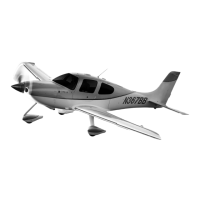Cirrus Design Section 7
SR22 Systems Description
P/N 13772-002 7-93P/N 13772-002 7-93
Pulling the activation T-handle straight down generates the
greatest force.
A maintenance safety pin is provided to ensure that the activation
handle is not pulled during maintenance. However, there may be some
circumstances where an operator may wish to safety the CAPS
system; for example, the presence of unattended children in the
airplane, the presence of people who are not familiar with the CAPS
activation system in the airplane, or during display of the airplane.
The pin is inserted through the handle retainer and barrel locking the
handle in the “safe” position. A “Remove Before Flight” streamer is
attached to the pin.
• WARNING •
After maintenance has been performed or any other time the
system has been safetied, operators must verify that the pin
has been removed before further flight.
Deployment Characteristics
When the rocket launches, the parachute assembly is extracted
outward due to rocket thrust and rearward due to relative wind. In
approximately two seconds the parachute will begin to inflate.
When air begins to fill the canopy, forward motion of the airplane will
dramatically be slowed. This deceleration increases with airspeed but
in all cases within the parachute envelope should be less than 3 g’s.
During this deceleration a slight nose-up may be experienced,
particularly at high speed; however, the rear riser is intentionally
snubbed short to preclude excessive nose-up pitch. Following any
nose-up pitching, the nose will gradually drop until the airplane is
hanging nose-low beneath the canopy.
Eight seconds after deployment, the rear riser snub line will be cut and
the airplane tail will drop down into its final approximately level attitude.
Once stabilized in this attitude, the airplane may yaw slowly back and
forth or oscillate slightly as it hangs from the parachute. Descent rate
is expected to be less than 1700 feet per minute with a lateral speed
equal to the velocity of the surface wind. In addition, surface winds
may continue to drag the airplane after ground impact.
• Caution •
Ground impact is expected to be equivalent to touchdown
from a height of approximately 13 feet. While the airframe,
Reissue A

